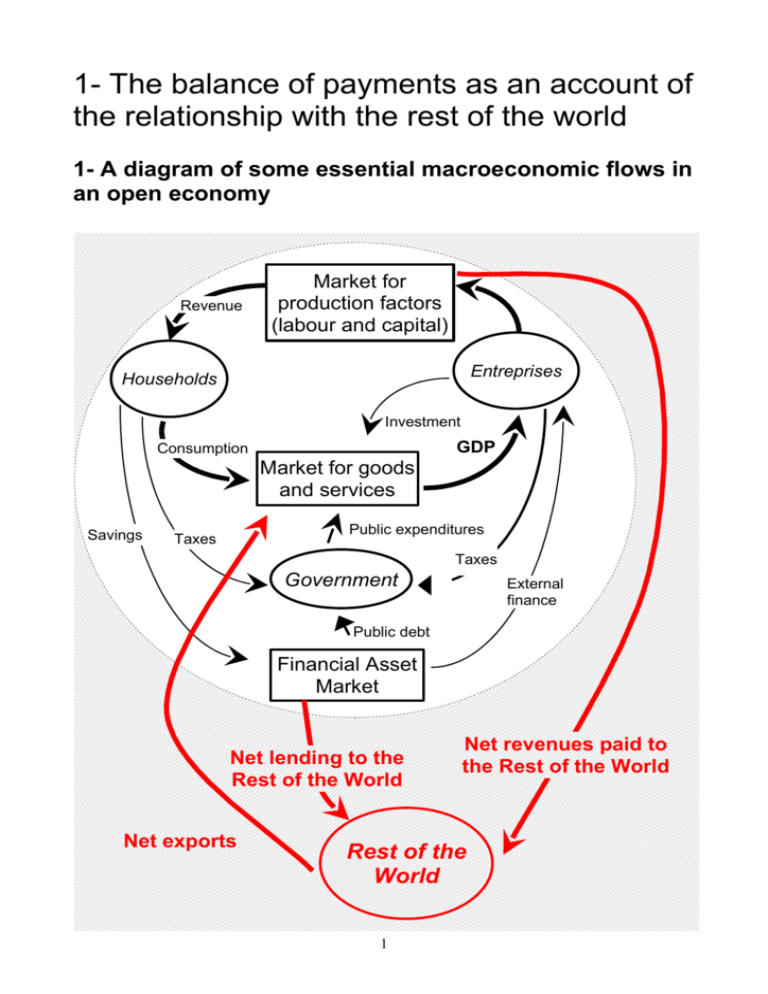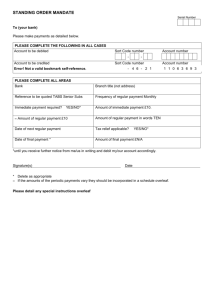
1- The balance of payments as an account of
the relationship with the rest of the world
1- A diagram of some essential macroeconomic flows in
an open economy
Revenue
Market for
production factors
(labour and capital)
Entreprises
Households
Investment
GDP
Consumption
Market for goods
and services
Savings
Public expenditures
Taxes
Taxes
Government
External
finance
Public debt
Financial Asset
Market
Net lending to the
Rest of the World
Net exports
Net revenues paid to
the Rest of the World
Rest of the
World
1
2- Definitions
a- balance of payments
The methodological basis of the balance of payments is set out in the Balance of
Payments Manual of the IMF (5th edition) published in 1993 (BPM5).
http://www.imf.org/external/np/sta/bop/bopman.pdf
BPM5 is currently under revision and a new version of the manual will be released in 2008.
Previous editions were issued in 1948, 1950, 1961, and 1977.
“The balance of payments is a statistical statement that systematically summarizes, for a
specific time period, the economic transactions of an economy with the rest of the world.”
(BPM5)
Keywords:
1- “Transactions”
(i) Exchanges of goods, services, income, financial claims and liabilities
(ii) Transfers of consumption goods, services, income or capital goods (“gifts”
involving no payment)
“Despite the connotation, the balance of payments is not concerned with payments, as
that term is generally understood, but with transactions.” (BPM5)
2- “An economy with the rest of the world” residents and non-residents
3- “For a specific time period” (as for any economic flow: a transaction itself is defined as
an economic flow ≠ stock)
4- “Systematically summarizes” not all-encompassing, but still consistent
The balance of payments is broken down into three broad sub-balances according to the
type of operations involved in transactions
(a) the current account; b) the capital account;
c) the financial account
b- international investment position
“Closely related to the flow-oriented balance of payments framework is the stock-oriented
international investment position. Compiled at a specified date such as year end, this
investment position is a statistical statement of
(i)
the value and composition of the stock of an economy’s financial assets, or the
economy’s claims on the rest of the world, and
(ii)
the value and composition of the stock of an economy’s liabilities to the rest of
the world.” (BPM5)
2
Australian Bureau of Statistics (http://www.abs.gov.au/)
3
3- The accounts of the balance of payments
http://europa.eu.int/estatref/info/sdds/fr/bop/bop_base.htm
a) CURRENT ACCOUNT
The Current account is divided into four basic components: goods, services, income and
current transfers.
a.1 - Goods
BoP item Goods covers general merchandise, non-monetary gold and, since the
implementation of the BPM5, goods for processing, repairs on goods and goods procured
in ports by carriers.
The most important component, General merchandise, includes all movable goods whose
ownership is transferred from a resident to a non-resident and vice versa.
When calculating the balance of payments, both exports and imports of Goods should be
valued free-on-board (f.o.b.). When a cost-insurance-freight (c.i.f.) valuation is provided,
freight and insurance components have to be estimated separately and eliminated from
the trade figures to arrive at a f.o.b. valuation. These components are then recorded in the
services account.
a.2 - Services
Services are the second major category of the current account.
The main breakdown of services includes three sub-items: transportation, travel, and other
services.
Transportation covers services provided by all modes of transportation - sea, air, and
other, which includes space, rail, road, inland waterway and pipeline - that are performed
by residents of one economy for those of another. The different types of services offered
include transport of passengers, transport of freight and other supporting and auxiliary
services (e.g., storage and warehousing).
The debit side of the item Travel consists of goods and services which are acquired by
residents who stay abroad for less than one year. The credit side includes purchases of
the same type made by foreign travellers on the national territory. This item contains two
main categories of travel: business travel and personal travel (leisure, study, health-related
purposes, etc.).
Other services comprise those international services transactions not covered under
transportation and travel (communication services, construction services, insurance
services, financial services, computer and information services, royalties and license fees,
other business services, personal, cultural and recreational services, and government
services n.i.e.).
a.3 - Income
Income covers two types of transactions between residents and non-residents.
Compensation of employees records wages, salaries and other benefits, in cash or in kind,
earned by individuals for work performed for economic units whose place of residence is
different from their own (border workers, seasonal workers, employees of international
organisations, etc.). It records money paid to non-resident workers or received from nonresident employers.
4
Investment income is income derived from ownership of external financial assets and
liabilities and payable by residents of one economy to residents of another economy. It
includes interest, dividends, remittances of branch profits, and direct investor's shares of
the retained earnings of direct investment enterprises. In line with the related financial
account, Investment income is classified in Direct investment, Portfolio investment, and
Other investment income.
a.4 - Current transfers
Current transfers cover international transactions in which goods, services, or financial
items are transferred between the residents of one economy and the residents of foreign
economies without something of economic value being received in return (quid pro quo).
These resources are immediately consumed or shortly consumed after the transfer is
made. Current transfers are all transfers that are not capital. Current transfers are broken
down, according to the sector of the compiling economy, into two subcomponents: general
government and other sectors.
General government covers cash transfers and gifts to/from other governments etc. (in the
European Union: contributions to the budget of the European Union institutions, flows from
the European Union institutions).
Other sectors include workers' remittances, residents' contributions to foreign social
security schemes, etc.
b) CAPITAL ACCOUNT
This item covers all transactions that involve (a) the receipt or payment of capital transfers
(debt forgiveness, migrant's transfers, etc.) and (b) the acquisition/disposal of nonproduced, non-financial assets, which includes transactions associated with tangible
assets (e.g., land and subsoil assets) and transactions associated with intangible assets
(e.g., patents, copyrights, trademarks, franchises, etc.).
c) FINANCIAL ACCOUNT
The Financial account covers all transactions associated with changes of ownership in the
foreign financial assets and liabilities of an economy. The financial account is broken down
into four basic components: Direct investment, Portfolio investment, Financial derivatives,
Other investment and Official reserve assets.
c1. Direct investment
Direct investment implies that a resident investor in one economy has a lasting interest in,
and a degree of influence over the management of, a business enterprise resident in
another economy. The lasting interest implies the existence of a long-term relationship
between the direct investor (resident entity) and the enterprise (direct investment
enterprise) and a significant degree of influence by the investor on the management of the
enterprise. Direct investment comprises the initial transaction between the two entities that is, the transaction that establishes the direct investment relationship – and all
subsequent transactions between the entities and among affiliated enterprises, both
incorporated and unincorporated. Direct investment is classified primarily on a directional
basis: resident direct investment abroad and non-resident direct investment in the
5
reporting economy. Within this classification the BPM5 distinguishes three main
components: equity capital, reinvested earnings and other capital.
c2. Portfolio investment
Portfolio investment records the transactions in negotiable securities with the exception of
the transactions which fall within the definition of direct investment or reserve assets. The
BPM5 first classifies portfolio investment by assets and liabilities. Within this classification
it distinguishes four main components: equity securities, bonds and notes, money market
instruments, and financial derivatives.
c3. Other investment
This is a residual category. Other investment is the investment which is not recorded under
the other headings of the financial account (direct investment, portfolio investment,
financial derivatives or reserve assets). It also encompasses the offsetting entries for
accrued income on instruments classified under other investment. Like portfolio
investment, other investment is first classified into assets and liabilities. Within the
directional classification four types of instruments are identified: trade credits, loans,
currency and deposits, other assets and other liabilities.
c4. Official reserve assets
These are foreign financial assets available to, and controlled by, the monetary authorities
for financing or regulating payments imbalances or for other purposes. Reserve assets
consist of monetary gold, Special Drawing Rights, reserve position in the International
Monetary Fund, foreign exchange, and other claims. Changes in the holdings of reserves
may reflect payments imbalances or responses to them, official exchange market
intervention to influence the exchange rate, and/or other actions or influences.
6
4- Double-entry System
“The basic convention applied in constructing a balance of payments statement is that
every recorded transaction is represented by two entries with equal values. One of these
entries is designated a credit with a positive arithmetic sign; the other is designated a debit
with a negative sign. In principle, the sum of all credit entries is identical to the sum of all
debit entries, and the net balance of all entries in the statement is zero.” (BPM5)
For example, when an exporter sells (provides) goods to a non-resident, the exporter may
receive cash (a financial asset) or another type of financial asset (e.g. a trade credit claim)
in return. The export is represented by a credit entry and the financial asset acquired is
represented by an offset debit entry.
Credit entries are required for exports of goods and services, income receivable, and
increases in liabilities or reductions in assets. Likewise, debit entries are required for
imports of goods and services, income payable, and increases in assets or reductions in
liabilities.
Where something of economic value is provided without something of economic value in
exchange (i.e. without a quid pro quo) the double entry system requires an offset to be
imputed (a transfer entry) of equivalent value.
For example, food exported as aid requires a credit entry for the goods provided and a
debit transfer as the aid offset.
RULES FOR THE DOUBLE ENTRY SYSTEM
Credit entries, all economic
Debit entries, all economic
resources provided by the compiling resources received by the compiling
economy, including:
economy, including:
• Exports of goods and services.
• Imports of goods and services.
• Income accruing to residents
• Income accruing to nonfrom non-residents.
residents from residents.
• Claims on residents provided to
• Claims on residents returned
non-residents; and resident
from the rest of the world; and
claims on the rest of the world
claims on the rest of the world
returned to the rest of the
provided to residents.
world.
• Transfers, which are offsets to
• Transfers, which are offsets to
debit entries.
credit entries.
7
EXAMPLES OF DOUBLE ENTRY RECORDING
1- Sale of goods (value 100) to non-residents for foreign exchange (i.e. goods provided and bank
payment (a bank deposit) received)
Credit Debit
Goods
100
Bank deposits, foreign currency assets
100
2- Purchase of goods (value 120) from a non-resident using trade credit (i.e.goods received and a
claim by a non-resident on a resident (trade credit liability) provided)
Credit Debit
Goods
120
Trade credit liabilities
120
3- Food aid (value 5) provided to non-residents (i.e. goods provided and transfer imputed)
Credit Debit
Goods
5
Current transfers
5
4- Repayment of a loan (value 25) by a resident company to a non-resident (i.e. liability to a nonresident returned reduced and a reduction in bank deposits)
Credit Debit
Loan repayment
25
Bank deposits, foreign currency assets
25
Australian Bureau of Statistics (http://www.abs.gov.au/)
Residual item (non-recorded transactions and statistical errors, net)
In principle, given complete and accurate recording, the overall balance of payments (i.e.
the combined current and capital account and the financial account) should sum to zero.
In practice, however, the accounts frequently do not balance. Data for BoP items are often
derived from different data sources. Timing, valuation and other factors cause imbalances
in the information recorded. The item “Net errors and omissions” is used to balance the
Current and Capital account with the Financial account.
RECAP:
In principle: CA+ KA + FA = 0
In practice: CA + KA + FA + Net errors and omissions = 0
Another presentation: Transactions in official reserve assets are excluded from the
financial account
In principle: CA + KA + “Financial Account” = Transactions in official reserve assets
In practice: CA + KA + “Financial Account” + Net errors and omissions = Transactions in
official reserve assets
8
US balance of payments
6%
5%
4%
3%
2%
TRADE BALANCE
BALANCE ON GOODS & SERVICES
1%
BALANCE ON GOODS, SERVICES & INCOME
CURRENT ACCOUNT BALANCE
0%
CAPITAL ACCOUNT BALANCE
FINANCIAL ACCOUNT BALANCE
-1%
NET ERRORS & OMISSIONS
RESERVES
-2%
-3%
-4%
-5%
9
2003
2001
1999
1997
1995
1993
1991
1989
1987
1985
1983
1981
1979
1977
1975
1973
-6%
German balance of payments
30%
20%
10%
TRADE BALANCE
BALANCE ON GOODS & SERVICES
BALANCE ON GOODS, SERVICES & INCOME
CURRENT ACCOUNT BALANCE
0%
CAPITAL ACCOUNT BALANCE
FINANCIAL ACCOUNT BALANCE
NET ERRORS & OMISSIONS
RESERVES
-10%
-20%
10
2003
2001
1999
1997
1995
1993
1991
1989
1987
1985
1983
1981
1979
1977
1975
1973
1971
-30%
source: IMF - % GDP
Japanese balance of payments
5%
4%
3%
2%
TRADE BALANCE
1%
BALANCE ON GOODS & SERVICES
BALANCE ON GOODS, SERVICES & INCOME
CURRENT ACCOUNT BALANCE
0%
CAPITAL ACCOUNT BALANCE
FINANCIAL ACCOUNT BALANCE
NET ERRORS & OMISSIONS
-1%
RESERVES
-2%
-3%
-4%
11
2003
2001
1999
1997
1995
1993
1991
1989
1987
1985
1983
1981
1979
1977
-5%





